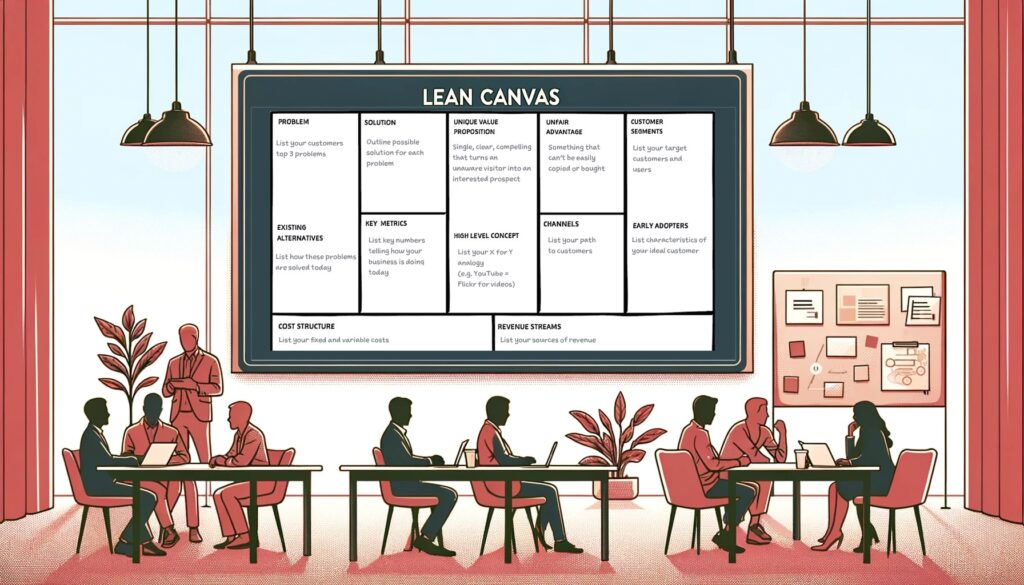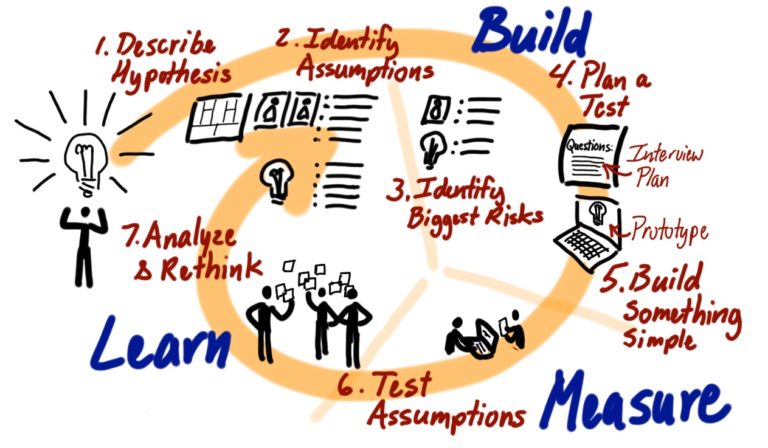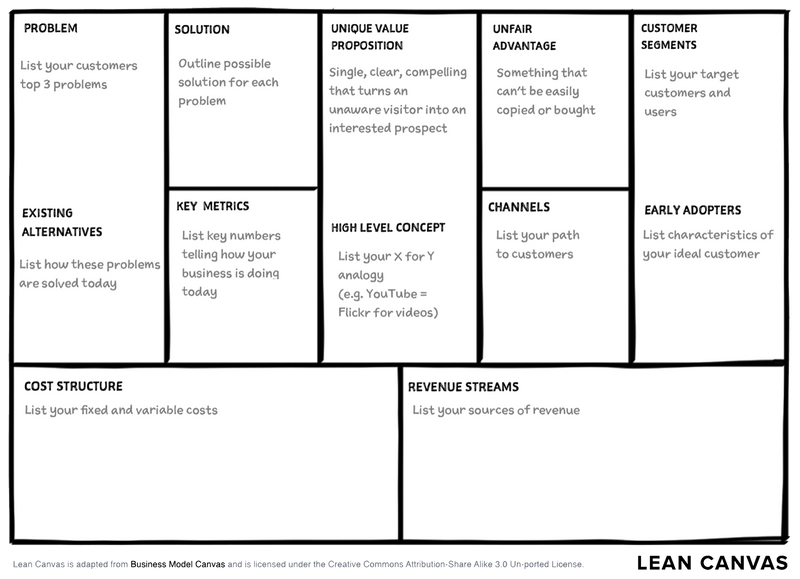
I have lost count of the number of mobile startups I have visited where they have Lean Startup by Eric Ries on the table or bookshelf. The truth of the matter is that the book isn’t that accessible. Many people read it and don’t really know where to start. Others, who persevere, sometimes apply the techniques when they aren’t suitable.
In this article I take a look at the Lean Startup method, give some pointers where to start, identify limitations and provide some tips specific to mobile development.
The Lean Startup Method
The Lean Startup Method was devised by Steve Blank and Eric Ries as a way to create a new business by repeating build | measure | learn while identifying risks and testing assumptions. You document your plan, identify the risky areas and create lean experiments to exercise and evolve the plan.

From Common Agile isn’t For Startups
Steve Blank provides a great introduction in his post on Why the Lean Start-Up Changes Everything. He explains how to replace elaborate planning with experimentation, intuition and customer feedback. The emphasis is on iterative design instead of large up front development.
The above post and the book provide lots of theory but unfortunately few action points. A better place is get started is the much more pragmatic and actionable Running Lean authored Ash Maurya that’s part of the Lean series by Eric Ries – author of the original book. Ash took Business Model Generation and developed a Lean Canvas.

Limitations of the Lean Startup Method
Lean, or any method for that matter, is never the best way for every project. You will regularly read that some methodology or programming language is the best and only way. The problem is that inexperienced people read this, believe it and projects projects go astray by design. It’s necessary to look deeply at methodologies and your project and determine if there’s a match.
Here, I cover some limitations of Lean. This is not to attack Lean but so that you can determine if it’s suitable for your startup.
Availability of VC Funding
The origins of Lean came about after the 2000 recession when VC funding was sparse and new businesses needed to preserve what little capital they had while surviving as long as possible.
Most, but not all, VC funds don’t like the idea of Lean because it goes against their goals of scaling very quickly.
Every start-up is in a furious race against time. The start-up must find the product-market fit that leads to a great business and substantially take the market before running out of cash
BEN HOROWITZ, CO-FOUNDER AND GENERAL PARTNER, ANDREESSEN
Startups are inherently designed to face a high rate of failure, as the few that succeed often achieve remarkable success. In contrast, the lack of a fit between product and market typically leads to expected failure. Since considerable funds and commitment are poured into initial ideas, companies aren’t anticipated to carelessly refine early concepts. When a surplus of venture capital available, it often seems more rational to make significant, swift investments, accepting the risk of failure, rather than taking time to adjust for a better product-market fit. The primary goal is to be the first to excel and dominate the market, regardless of the expense.
However, there are a few important things to consider. Firstly, venture capital isn’t necessarily the best or chosen path for every startup. Secondly, venture capital isn’t always readily available. Finally, it’s possible to seek venture capital funding after employing Lean methodologies to confirm the suitability of your product in the market.
False Positives
Projects that come out of Lean might have product/market fit but can still subsequently fail. Such false positives fail for reasons other than product/market fit such as the resultant product, having iterated, not being as exciting to the stakeholders as the original prospect. Moving too many steps away from an original idea also tends to move you, each time, slightly further away from the original problem to the point where the new problem might not be worth solving. You can end up with a product/market fit for something not worth doing.
As another example of a false positive, there can be problems further down the line building and scaling the product or successfully winning against competitors. This is the situation where VC funding excels.
False Negatives
False negatives also occur when something is rejected, for example, due to unlucky market timing. What might not be viable today might become viable tomorrow. It’s easy to give up too early. It could be your product is one where customers don’t yet know what they want. As mentioned in What the Lean Startup Method Gets Right and Wrong, Steve Jobs once said:
“It isn’t the customer’s job to know what they want“
If your product anticipates what customers might want in the future then the Lean method might not be suitable.
Another example of a false negative is for the class of problems that only become solvable with a complete, full solution. These are ones where you need the whole thing before a valid assessment can be made if it’s viable.
Slow Acceptance
Lean isn’t suitable for ideas that need time to take hold. Lean is quick to abandon ideas and if this velocity is greater than the time needed for end-users to accept a new way of doing things then you might end up moving on too soon and losing a valid product. Big, slow ecosystem type solutions in energy, healthcare, food and agriculture can take a while to play out.
Technical Debt
Another danger with Lean is that it can encourage quick and dirty implementations that subsequently become part of the final solution. It takes strong leadership to avoid technical debt.
Mobile Development Considerations
Given the crowded nature of mobile app markets and the expense of developing for iOS, Android and server, validating your app idea before full-scale development is much more pertinent.
The decision between developing native apps for each platform versus using a cross-platform approach affects the lean startup process. Cross-platform development can speed up the initial launch and learning phases by enabling rapid deployment across multiple platforms, but it often introduces unacceptable trade-offs in terms of usability, performance and access to platform-specific features.
Due to smaller screen than the desktop, user experience and design are very important and can be critical to adoption and retention. Lean Startup methodology in mobile development often involves continuous A/B testing and user experience improvements to ensure the app not only meets the functional needs but also delivers a seamless and engaging user experience.
A core component of the Lean Startup methodology involves building the prototype, measuring how it performs in the market and learning from the results. In mobile development, this can be facilitated by various analytics and user feedback tools designed for mobile apps such as Firebase Analytics and Crashlytics.
The strategies for launching and distributing mobile apps are influenced by the rules and algorithms of app stores. Understanding and optimising for these can be crucial for visibility and success. Tools such as AppFollow can guide you to focus on key metrics that app stores value, such as user reviews and engagement and iterate the app based on performance in these areas.
I have seen that acquiring users for testing and feedback can be expensive and challenging, especially for startups with limited budgets. The cost of acquiring users through advertising or promotional offers can quickly escalate, making it difficult to sustain the iterative testing and development cycles advocated by the Lean Startup method.
Mobile development is subject to the constraints and guidelines of app stores and platforms (iOS and Android), which can limit the ability to iterate quickly. App updates must be approved by app stores. On iOS in particular, this can slow down the iteration process and delay feedback loops, especially for contentious apps that use background activities. On both platforms, while iterating, care much be taken to ensure the app continues to comply with data privacy and security requirements to ensure review failures don’t slow down the lean cycle.
Summary
Lean methodology isn’t appropriate for every startup and there are considerations specific to projects involving mobile development. Lean necessitates an evaluation of the prevailing market conditions and a thorough analysis of the issue your business aims to address. For instance, is your new venture better suited for rapid scaling that requires venture capital? If that’s the case, is there a plentiful supply of venture capital currently available? Regarding the problem being solved, is it feasible to develop a viable, lean prototype? Is it a situation where the customer is unaware of their need for your solution? Will their need take a long time to determine?








